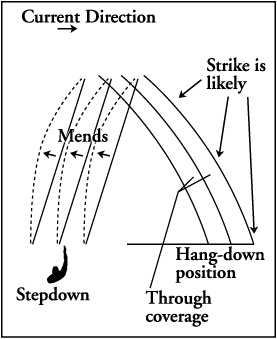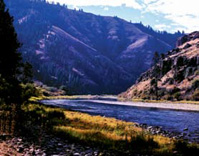Wet Fly Swing
The wet fly swing is used to present the fly in large riffles. Whenever the lie of a fish is uncertain, the wet fly swing system is helpful in discovering secluded fish. Nearly all of a riffle can be covered by adding a step-down between casts. It is a productive manner to fish both attractor and baitfish flies; furthermore, it’s a favored steelhead method. The fly’s swing conveys a lifelike appearance to its materials. With the wet fly swing both the surface and the depths of a run can be covered. A floating line is chosen to cover the surface while a sinking tip line is engaged to fish the bottom. The wet fly swing is performed as follows:
- The cast is made slightly quartering downstream.
- The line is mended as necessary to either slow or speedup the fly’s drift. The mend’s direction relies upon the current’s mixed velocities in relation to the fly and line.
-
As the fly swings through its arc, track the fly’s movement with
the rod tip.

- When the fly’s swing ceases at the hang-down position, jig the fly and pause it to excite a strike from a following fish.
- Step downstream a predetermined distance then recast the fly for the next presentation. This step-down provides the thorough coverage of the wet fly swing.


© 2025 The Gale Group, Inc. All rights reserved.
© 2025 Perigee Learning LLC. All rights reserved.
LoveTheOutdoors.com is owned and operated by Advameg, Inc. © 2025 Advameg, Inc.
Camping Adventures • Dutch Oven Cooking • Sports Knots
Fly Tying • Freshwater Fishing • Fly Fishing

